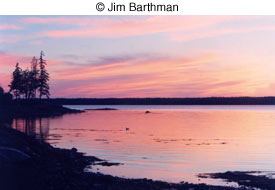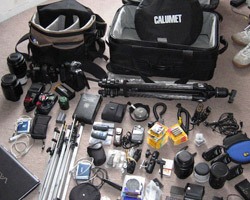I like vacations. But for some inexplicable reason, I always forget to take them. Maybe it's because I like my work so much. I don't know. What I do know is that after this last escape, I don't think I'll be so quick to forget.

After surprisingly little deliberation, my wife and I decided to spend our rare, work-free week exploring the beautiful state of Maine, specifically, the awe-inspiring rocky coastline that extends from Rockport/Camden to Acadia National Park. To make things interesting, (why be ordinary?) we decided to travel by way of a rented 24-foot mini-motor home; a 6-wheeled, 10-cylindered, behemoth road monster that offered more square footage than most New York City studio apartments.
The nomadic freedom of our rolling home, we rationalized, would allow us to photograph our way up scenic Route 1. at our convenience. This rig had everything, an onboard refrigerator, stove, microwave, queen-sized bed (actually more comfortable than the bed at home), dinette, air conditioning, bathroom, and shower. Hardly a retreat from civilization, our motor home would provide a great base for each of the many hiking trips we had planned. Our brief yet thorough research of the area revealed that this part of Maine, and especially Acadia, has an abundance of trails that are suitable for anyone and everyone. These easy to access pathways into the wilderness would be perfect for my style of photography
Before you embark on any excursion, such as this, you should do a little planning first. Let's discuss the photographic planning.

Choose Your Equipment
What kind of camera should you bring? Digital camera or film? That's a personal decision that I'm betting you've probably already answered. Whatever system you decide to take, consider the pros and cons first.
For this trip I decide to go with my 35 film cameras. Here's why:
1. Enlargement potential
I know that the 35mm negatives will be suitable for making 11 x 14s or even a 14 x 17 prints if I want. My current digital point-and-shoot is capable of making impressive 5 x 7s, however enlargements bigger than that don't impress me at all. My main digital camera is a studio model that's not suited for "life on the road.
2. Back-up camera
I have a back-up film camera. Should the first camera decide to stop working, I won't have to. I only have one digital camera available to me for this trip. When you're away from home, have a back-up camera.
3. Equipment diversity
My 35 mm camera system affords me better lens choices. While I do like the zoom lens on my digital camera, but my tried and true Nikkor lenses are far superior.
4. Fewer batteries required
The film cameras use less battery power. Who wants to be thinking about batteries in the wilds of Maine?
I pack two 35mm camera bodies and my three favorite lenses. A 28mm for wide landscapes, a 55mm Micro Nikkor that serves as both a normal lens plus has the added benefit of being an excellent macro lens perfect for close-up work. A 70-210mm zoom lens rounds out my lens collection. I wasn't always a fan of the zoom lens however, since we will be doing a fair amount of hiking, my goal is to travel light. Truth be told, the quality of most modern zoom lenses today is excellent.
Make A Checklist
Once you have chosen your equipment, make checklist. You won't really appreciate this step until the next time you go on vacation. Do it anyway. You will be rewarded later, I promise. I can't tell you how many times a checklist has saved me when shooting on-location. When you're a thousand miles from home you don't want to forget anything. A checklist will help tremendously.
My Equipment Checklist
One week in Maine, light hiking, low light photography
- 2-Nikon FM 35mm camera bodies
- 1-35mm Nikkor 2.8
- 1-5mm Micro Nikor 1.8
- 1-70-210mm Nikkor Zoom 3.5-5.6
- 2-Cable releases
- Lightweight Gitzo tripod
- Sekonic digital light meter
- Kitchen timer (long exposures)
- Swiss Army knife
- Small flashlight (low-light/night photography)
- Film
- Batteries
- AA batteries (light meter)
- Button batteries (camera)
- Ziploc bags to keep camera and equipment dry and clean.

Refine Your checklist
While you are on vacation, add and subtract items to your list as you see fit. Don't count on remembering, (that's why you make the list), pencil it in, right away. When you get home take your notes and create a new, clean, more efficient checklist. That way, you'll be ready for your next trip.
Film
What's your preferred film? Most photographers have a favorite brand/ speed etc. Whatever yours is, buy lots of it. More than you think that you will ever need. There is no worse feeling than running out of film during a golden photo opportunity. For most serious amateurs a good slow speed (200 ISO) negative film will serve nicely. Remember, the lower the ISO, the higher the resolution of the film. Higher resolution film increases the enlargement potential of your images.
Because of the latitude of modern day negative films, getting the right exposure is a snap. You can actually be one stop off in exposure, in either direction, and still get a good negative suitable for printing. Negative film makes life simpler. If you decide to shoot slide film, be sure to bracket (taking multiple shots of the same scene at different exposure settings), and remember to adjust the amount of film you buy accordingly.
Digital Film
If you are shooting digitally, you'll need to bring plenty of memory cards. The good news is memory cards prices continue to drop as there maximum storage capacities increase. You can purchase 256 or 512 MB cards today at a mere fraction of the price they were just a few years ago.
Digital photography requires that you choose an appropriate image quality setting too. Here's what to remember.
Higher quality = bigger enlargements
Lower quality = smaller enlargements
Higher quality = fewer images on a single memory card
Lower quality = more images on a single memory card
When shooting on-location, quite often I choose the highest quality setting that employs a low-level JPEG compression. This ensures that I can get more than a few images on a single memory card and still get reasonably sized enlargements.
If you shoot on location with a digital camera a lot, consider one of the many portable hard drives on the market today that are geared specifically for digital photography. They allow you to download your memory cards while you are shooting, providing an almost limitless amount of digital image storage space. Some of the newest laptop computers are also offering slots for Compact Flash, Smart Media and other digital camera media, perfect for downloading on the go.
Pack Carefully

I am hard on my equipment. All this stuff is packed in a good padded bag. In my own defense, it's really not my fault. I sometimes get so excited by what's in front of my lens that I simply drop everything in order to get the shot. Good padding means that my expensive lenses, bodies, and light meter are protected as much as possible from my frequent states of delirium. The bottom line: travel light and protected.
Test Your Equipment
Check your cameras and equipment to make sure everything is operating properly. Leave yourself some time beforehand, in case you do need to rent or borrow equipment.
Light is Everything
When shooting in nature, we rely on the sun as our main light source. Most professional photographers know that the best light of the day comes at two times, the beginning and the end of the day. Because of the angle of the light, early and late day sun reveals shapes and textures you won't see at high noon. At these times, dramatic light rakes across the earth's surface revealing texture through the interplay of light and shadow. Don't forget about the shadows. Shadows are as important as the light itself. In fact you can't have one without the other. Long shadows accentuate shapes, revealing patterns and textures too. Plan your shots while the light is high but don't start shooting until the light gets interesting. One of the reasons late afternoon or early morning light is so special is that it is seen for only the briefest of moments each day. Seize the light!

Be Prepared for Anything
Whenever you go hiking in a strange land, be sure to dress appropriately. By wearing layers you'll ensure you can accommodate changing weather conditions. Don't be fooled. Hypothermia, a lowering of the body's core temperature, is a serious condition that can happen in the middle of summer. Symptoms of hypothermia may include uncontrollable shivering and disorientation. Should you exhibit any of these symptoms, seek medical attention. To get the best information about an area, talk to locals. They can always steer you to the right places at the right time. Many of the state-run tourist bureaus can provide great maps and literature too.
Lastly, follow the park rules and regulations and leave it as if you have never been there.
Although I have traveled all across the world, I am guilty of having never visited some of the world's most beautiful places found right here in America. Although the splendor of Acadia National Park was a mere 9 hours away from my upstate New York home, in reality, it was a world away. Quite often many of us forget how beautiful our country really is; sometimes all you have to do is look out your back door.
Just a note:
One thing you don't want to forget when traveling by mini-motor home: Gaffers tape. Ten minutes into our trip we made a right turn and proceeded to watch a gallon of milk come flying out of the "locked" refrigerator. Apparently it's a rite of passage for first time RV renters. Tape your refrigerator door shut and you can save a gallon or two.
Learn how to get the best photos from your vacation with our online photography classes.






